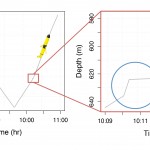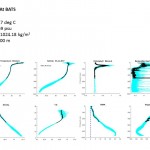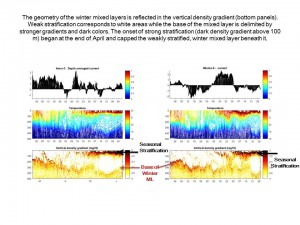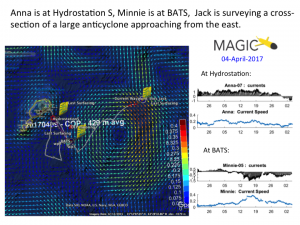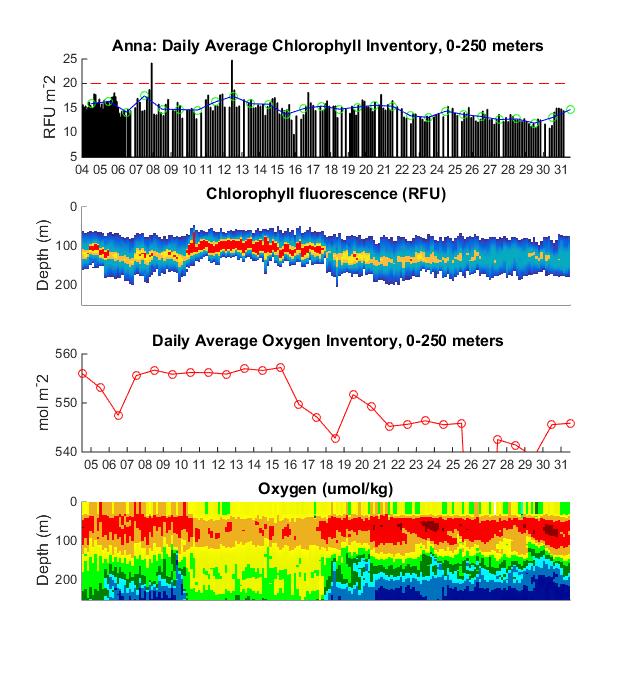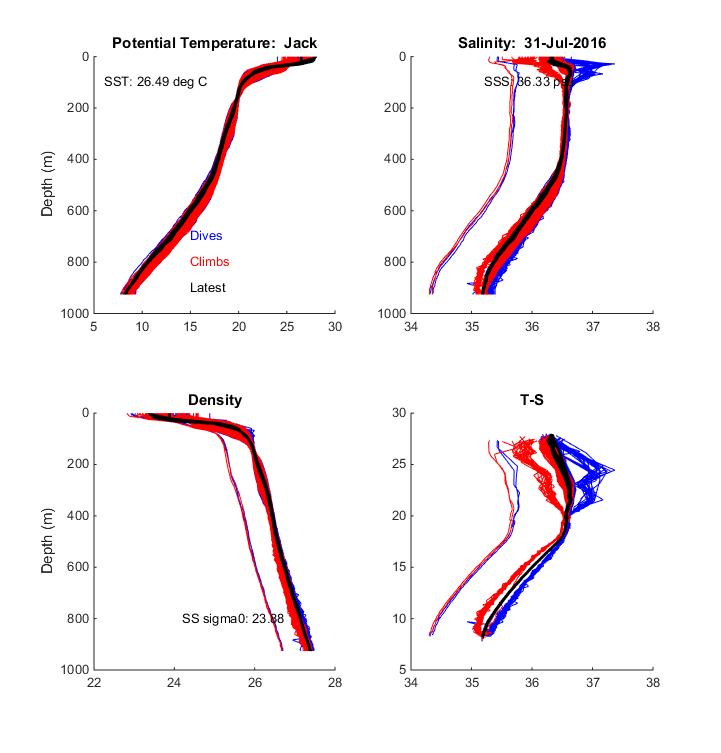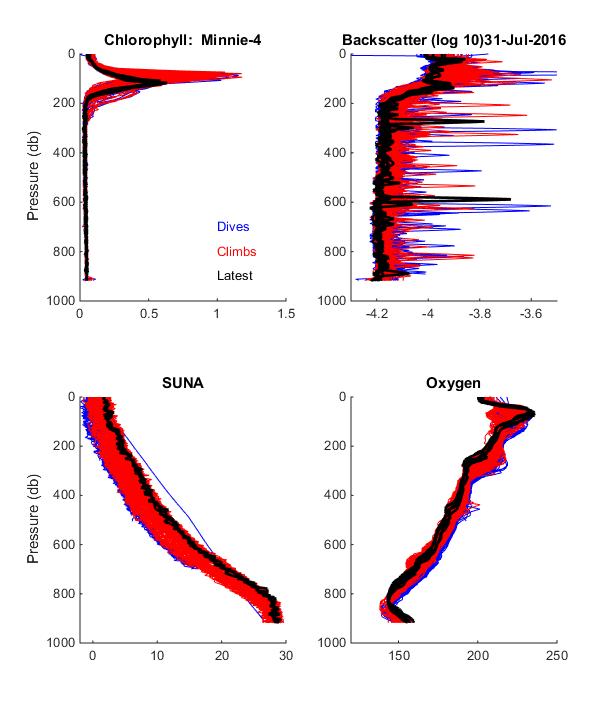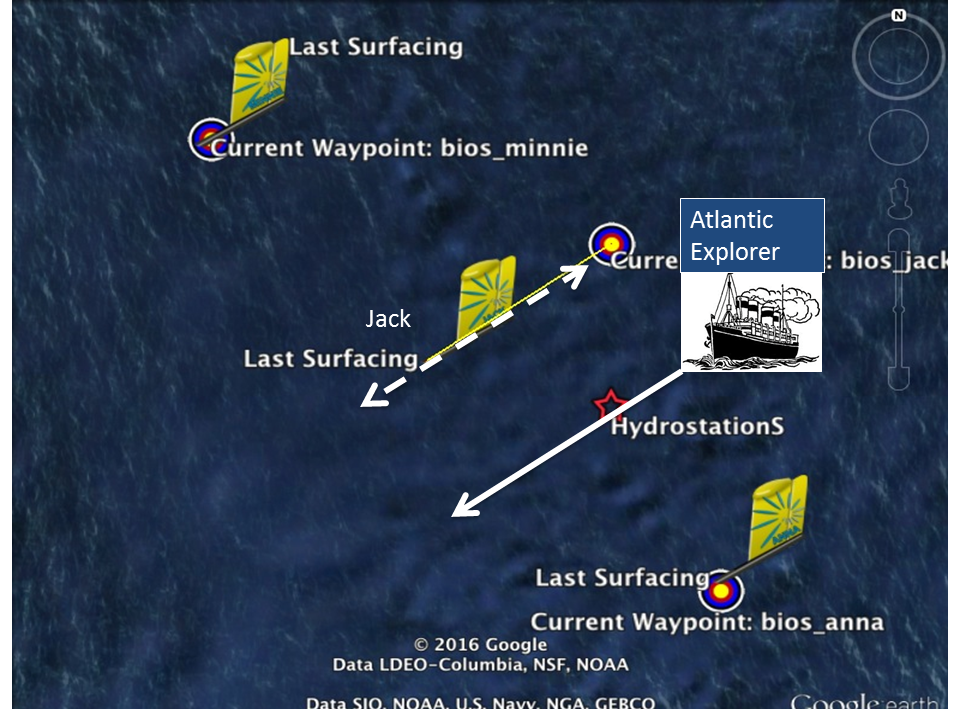In the Water Now: 16 July Update: Plagues and Predators
The pandemic came in the wake of a series of nine mission-disrupting incidents between May 2019 and Feb 2020 that appeared to be fish attacks on the gliders. The damage ranged in severity from lost wings and broken tail rudders, which were easily replaced, to the sudden and total disappearance of our glider “Anna” on November 7, 2019. In the first five years of piloting gliders in the Sargasso Sea, the MAGIC Lab experienced just two similar encounters, although, in reality, there may have been others that did not interrupt the missions. The gliders frequently returned from duty with telltale tooth-shaped bite marks and scratches on their hull and tail sections.
Most curiously, all of the fish strikes occurred in the twilight regions of the ocean, between 240 and 800 meters, rather than in the biologically productive sunlit layers. We determined this by analyzing the gliders’ pressure profiles after recovery. In most cases, the glider’s dive or climb rate abruptly slowed (the fish holding it) or rapidly increased (glider hit from below during its climb toward the surface). Sometimes the vehicle was hit multiple times in a row. While we cannot confirm the identity of the organisms, the patterns of the bite marks suggest they are sharks, although large squid and/or dolphins might also be possibilities. A variety of shark species are known to frequent these waters, among them: great whites, makos, tiger sharks, porbeagles, and sixgills. The latest fish strike left teeth fragments embedded in the glider’s tail providing the potential to sequence DNA for a positive ID.
While it’s exciting to think about such large creatures patrolling the ocean depths, these encounters resulted in serious interruptions to sampling and, in the case of Anna, the complete loss of 2 months worth of data stored on the glider’s flash card, plus the expensive SUNA sensor the glider was carrying. The last two attacks on “Jack” and “Minnie” destroyed their tail sections, requiring costly and time-consuming repairs back at the factory.
The vehicles and sensors are insured against loss, which enabled us to purchase a replacement (“Anna2”!). The rest of the glider fleet is back in good repair, ready for action, and we have been brainstorming about ways to mitigate these fish attacks. Our leading hypothesis is that light emitted by the optical sensors – the fluorometer and the SUNA – is attracting these predators, particularly in the dark layers of the ocean. The optical fluorometer measures phytoplankton abundance while the SUNA measures nitrate concentrations, both of which are essential to the experiment. Our strategy will be to turn these sensors off when the glider is below 400 meters, and to turn them on for deeper sampling once per week. Reducing light flashes deep in the water column will hopefully keep the curious and/or hungry locals at bay.
- The MAGIC gliders frequently come back from a deployment with new teeth marks on their hulls. Often these bitemarks are on the underside of the glider near the fluorometer (the circular copper puck integrated into the hull in this photo) – this sensor emits a light as it samples, which we hypothesize is attracting large predators.
- A number of the fish strikes have resulted in breaking off one of the glider’s wings. The loss of a 240- gram wing changes the glider’s weight and buoyancy, causing the vertical speed to slow on dives and increase on climbs, but by adjusting the oil volume being pumped, the glider can still limp along and be steered.
- In February 2020 Minnie was hit by a fish, this encounter not only left deep gouges in the glider, it also completely bent the metal rod that attaches the glider’s tail section. The tail section holds all of the glider’s communication antennas so Minnie’s tail had to be shipped back to the manufacturer to be rebuilt.
- Fragments of teeth embedded in Minnie’s tail after a fish strike in February. We are hoping to sequence DNA from these fragments to identify what type of animal is hitting the gliders.
- An example of shark strikes during Jack’s mission in December 2019. The interruption of the glider’s normal flight pattern is clear in the depth measurements. In this instance, the glider was hit twice in a row, about 4 minutes apart, between 610 meters and 640 meters. During the first strike, the glider was quickly moved upward through the water about 10 meters.
- A sixgill shark (Hexanchus griseus), one of the multiple species suspect in the attacks on the MAGIC program’s gliders over the last two years. Teeth fragments embedded in Minnie’s tail provide the potential to sequence DNA for a positive ID. (Photo courtesy NOAA Ocean Explorer from USA/Wikimedia Commons)
In the Water Now: 7 November Update
Jack is soloing in the water at the BATS site this fall after a very full Winter–Summer Field Campaign from Jan through July. The timeline for glider deployments (Fig. 1) depicts the significant ramp up of activities associated with the Spring Bloom and BIOS-SCOPE missions in 2017.
Post-processing and quality assurance of the full datasets is nearly complete and these are available as matlab files. A netCDF version for post-processed data and a web portal are being developed. Beginning this July, real-time data were uploaded on a daily basis to the U.S. IOOS Glider Data Assembly Center (DAC) for dissemination via GTS.
The summer glider schedule was marked by a number of unanticipated events. Jack was deployed June 28, but had to be recovered on July 28 following a suspected shark attack in which his tail rudder was lost. He was back in the water on Sept 20, but lost his port wing (another biological interaction???) and was recovered on Oct 16. The glider was re-deployed on Nov 3 and will remain in the water until late December.
The figures show Jack’s track line and present location and the ocean currents, sea surface height, temperature and stratification measured by BIOS gliders at the BATS site from June to November. As usual, the summer season was characterized by increasing near-surface stratification and declining plankton biomass in the nutrient-depleted photic zone. Biological production picked up slightly in October as seasonal winds strengthened, the surface waters cooled, and the mixed layer began to deepen.
Meanwhile back in the MAGIC Lab, our other 2 gliders, Anna and Minnie, are awaiting new science bays while their original sensors are being re-calibrated at the factory. The plan is to deploy them in December – Minnie carrying the SUNA sensor and Anna with a PAR (Photsynthetically Available Radiance) sensor to measure profiles of nutrient concentrations and light levels respectively. We also anticipate adding a microstructure package this spring to the trio of gliders to generate much-needed profiles of velocity and vertical shear to our broadening set of observations. These newest sensors will enable us to differentiate the processes that mix nutrients up into the photic zone (e.g. convective, shear and baroclinic instabilities), and place needed constraints on the amounts of nutrients and particulate carbon exchanged between the shallow and deeper layers.
- Timeline of glider missions since the inception of the MAGIC Program.
- Jack’s location relative to surface currents (from Copernicus model) on 07-Nov-2017. Very strong southwestward currents are sweeping through the BATS area, and mark the boundary between two counter-rotating eddies.
- Dynamic sea surface height (geopotential anomaly, GPA) and depth averaged currents. Strong currents are associated with fronts on the edge of eddies, such as the anticyclone (peak GPA) in early October. This feature contributed to abnormally high tides (> 2 ft above average) on the island.
- Time series of temperature and vertical stratification show the evolution of the upper 400 meter water column from summer to fall
- Time series of chlorophyll inventory and optical backscatter, proxies for phytoplankton biomass, show declines through the summer months followed by an increase in late September and early October as the surface stratification began to ebb and deepen.
In the Water Now: 3 July Update
All 3 gliders are back in the water (Figure 1). Anna has been profiling at Hydrostation S (HS) since Feb 20. Minnie (carrying a SUNA sensor) was redeployed at BATS on June 16 following a very successful 3-month Spring Bloom mission, and is again keeping station to extend those time series measurements into summer. Jack was recovered at BATS on June 16 and redeployed on June 28 at HS. For 2 days, Jack and Anna profiled in tandem to obtain cross-calibration of their sensors. For the next week, all three gliders will participate in a diurnal experiment: acquiring profiles to 500 m every hour to measure differences between daylight and nighttime conditions. A weak cyclonic eddy is approaching the BATS area from the east with southerly currents now occupying both sites.
As summer warms the ocean, SSTs at BATS and HS have increased to 26.17°C and 26.80°C, respectively. At both sites, deep chlorophyll maxima are found at 100 meters . Additionally, SSS is 36.60 psu at HS and 36.59 psu at BATS (Figures 2, 3, & 4 ).
Sea surface temperatures (SST) have been running higher since April compared to climatological values computed from the BATS, HS and Argo datasets (Figure 5). The minimum tropical storm SST (26ºC) is reached on average around day 190, while glider SSTs attained the 26ºC threshold closer to day 160 this year. The glider SSTs are about 1-2ºC higher than average providing a stronger than normal energy potential in the central Sargasso Sea as we enter Hurricane season.
This report was produced by Talia Rodkey, Lehigh Summer Intern for the MAGIC program.
- Figure 1
- Figure 2
- Figure 3
- Figure 4
- Figure 5
In the Water Now: 12 June 2017 Update
This week Minnie and Jack are being rotated in and out of the water while Anna continues to hold station at Hydrostation S (HS) (Figure 1). Sea surface temperatures are 24.7ºC at HS and 23.2ºC, about a degree and one half cooler, at BATS. Pronounced deep chlorophyll maxima (DCM) are found between 80 and 100 meters at both locations.
Jack was temporarily recovered on May 13 as strong currents associated with the westward-moving anticyclonic eddy (see 22 April update) overpowered the glider’s ability to steer. He was re-deployed on May 29 at HS, was piloted to BATS where he remained until the planned recovery later this week as his battery runs low.
Anna and Minnie, both deployed on February 20, produced a remarkable record of this spring’s phytoplankton bloom (Figure 3). At HS, chlorophyll inventories showed sporadic and short-lived bursts rising above the average 30 RFU m-2 (red line) in March, culminating in a sharp peak near April 1, and falling below average values shortly thereafter. In contrast, chlorophyll inventories at BATS rose above 40 RFU m-2 in early March, remained high until the end of April, and dropped to average values (30 RFU m-2) after that. These differences in chlorophyll production reflected variation in the winter mixed layer depths measured at each location (Figure 4). At BATS, the bottom of the mixed layer reached below 300 m in March whereas the mixed layer depth at HS was closer to 200 m. The sharp, early-April chlorophyll peak corresponded to a brief deepening of the mixed layer at HS and stretching of subsurface isopycnals.
Nitrate inventories in the photic zone (0 – 120 meters) measured by Minnie’s SUNA sensor closely paralleled the chlorophyll inventories (Figure 5). Nitrate levels rose above zero between March 8 and May 2 corresponding to chlorophyll levels > 30 RFU m-2 and signifying injections of nitrate from deeper layers. The next step is to calibrate the chlorophyll and nitrate profiles to high precision measurements acquired during ship occupations of the time series sites, and to assess the molar ratio of chlorophyll carbon to nitrate concentrations measured by the gliders.
- Figure 1
- Figure 2
- Figure 3
- Figure 4
- Figure 5
In the Water Now: 22 April Update
The strong anticyclone gyre has tracked mostly west and slightly south and appears to be headed for an intersection with BATS with the eddy’s center about 20 km south of BATS. Jack’s track for the past week or so has allowed it to circle the eddy and the glider is now on a northerly track through the eddy center. Profiles of T, S, and O2 are beginning to show the elevated values that are typical of a Gulf of Cadiz eddy (see the 9 April 2017 update). During the most recent BATS cruise, the BATS team searched for the eddy center and produced a vertical property profile for comparison with current conditions at BATS.
Anna and Minnie remain in place profiling at Hydrostation S and BATS, respectively, and both locations are warming and beginning to form cap in the upper water column near the surface. SSTs at BATS are 21.43 degrees C and at Hydrostation S are 20.58 degrees C. The mixed layer depth at BATS is now about 120 m, based on maximum density gradient, and a shallower cap is forming in the upper 70 m, above which nitrate (NO3) is no longer detectable. The chlorophyll maximum is located at about 100 m.
Vertical mixing appears to still be occurring below the photo zone but above the winter mixed layer transition zone at about 300 m. Elevated nitrate levels are no longer seen above about 70 to 100 m, although several episodes of vertical delivery of NO3 to the lower photic zone have occurred in the last week or two. The impact of the recent, strong vertical delivery of NO3 can be seen in the inventory plots as increased levels of chlorophyll and O2. During the interval of detectable NO3 in surface waters (from about 8 March to 9 April 2017) higher levels of chlorophyll are observed as well as an increasing O2 concentration reflecting an increase in productivity.In the last two weeks, the O2 levels from 200 to 300 m have significantly increased. It is unclear if this increase is locally produced or the result of advection.
- The eddy field near BATS on 23 April 2017
- Profiles from Jack as it crosses the anticylonic eddy east of BATS
- Profiles from BATS (left) and the center of the eddy (right) from 17-19 April 2017 during the most recent BATS cruise
- The anticipated track line for Jack as it crosses the center of the eddy
- Current conditions at BATS
- Current conditions at Hydrostation S
- Time series of the water column at BATS (0-500 m)
- Time series of the water column at BATS (0-300 m)
- Nitrate and chlorophyll inventories at BATS
- Chlorophyll and dissolved oxygen inventories at BATS
In the Water Now: 9 April Update
An anticyclonic eddy is approaching BATS from the east that contains water properties characteristic of the Gulf of Cadiz. Jack has explored the eddy properties in the last week and discovered unusually high temperatures, salinities and dissolved oxygen concentrations in the lower parts of the thermocline. In the last several weeks, O2 concentrations at about 900 m have varied dramatically from low values of about 120 mmoles kg-1 to high values of 220 mmoles kg-1. Zantop and Leaman (1982) first identified this type of eddy in the subtropical gyre of the North Atlantic and traced is characteristics to water properties resulting from winter convection in the Gulf of Cadiz. The BATS time series data contain three other instances of this type of eddy records at BATS: 1995, 2001 and 2008.
Anna and Minnie remain in place profiling at Hydrostation S and BATS, respectively. Convective mixing appears to have reduced from about 300 m to about 140 m at BATS as SSTs have warmed a bit. Elevated nitrate in the surface waters continues to result in higher Chl and particle concentrations, as well as elevated dissolved O2. Mixing in the transition layer continues to be the primary source of NO3 movement toward the photic zone and the most recent upwelling documented on or about April 4.
- The eddy field near BATS
- Profiles from Jack as it crosses the anticyclonic eddy east of BATS
- Profiles from previous Gulf of Cadiz eddies at BATS (1995, 2001, 2008)
- Current conditions at BATS
- Current conditions at Hydrostation S
- Time series of the water column at BATS (0-900 m)
- Time series of the water column at BATS (0-300 m)
- Nitrate and chlorophyll inventories at BATS
- Chlorophyll and dissolved oxygen inventories at BATS
In the Water Now: 27 March Update
Anna and Minnie were deployed from RV Atlantic Explorer on February 20, 2017 – Anna at Hydrostation S and Minnie at BATS. Anna is quipped with a standard set of sensors: CTD, optical fluorescence, backscatter and CDOM, and dissolved oxygen; Minnie is similarly equipped with the addition of a nitrate sensor. Both gliders are holding station and making about 8 dives each day. Jack was recovered February 27, had its battery replaced and redeployed on March 13, with standard sensors plus an Acoustic Doppler Current Profiler (ADCP). Since then, Jack has been observing the water column structure in transects between the BATS and Hydrostation S.
The local eddy circulation is complicated. BATS is on the boundary between 3 counter-rotating eddies: a strong Cyclonic Eddy to the NW, an Anticyclonic Eddy to the NE, and weak Cyclonic Eddy to the SE. Northerly winds and cooler air temperatures at BATS over the weekend resulted in convective overturning down to 300 m. Mixed layer temperatures at BATS are now below 20oC for the first time this year.
In addition to top-down convective overturning, the base of the Mixed Layer (ML) and the transition layer beneath it have exhibited Kelvin-Helmholtz instabilities, characterized by vertical heaving, stretching and squashing of the transition layer. Beginning in early March, these breaking internal waves have mixed cooler waters, nutrients and other tracers (such as salinity) up into the surface mixed layer and are a consequence of episodic wind forcing. This increase in the delivery of nitrate (NO3) to the photic zone increased phytoplankton productivity and has resulted in an increase in chlorophyll concentration, dissolved oxygen, and optical backscatter in the surface waters at BATS.
An additional, transient advective feature occurred in mid-March at BATS: anomalously low O2 at the deep O2 min, elevated NO3, low salinity, and spreading of isopycnals. It had limited spatial extent and was associated with strong depth-averaged flows.
In the Water Now: Winter-Spring 2017
“Jack” has been profiling the water column at Hydrostation S since early January. From February to June 2017, all three gliders will be used to conduct intensive sampling as part of continued efforts to understand plankton production and the “Spring Bloom” in the Sargasso Sea. Last year the gliders “Anna” and “Minnie” together measured events in which plumes of nutrient-rich waters were pumped up into the sunlit layers from below, spurring bursts of phytoplankton production measured as sharp increases in chlorophyll and oxygen concentrations. The episodes were associated with strong winds interacting with ocean currents and watermass properties, and occur on timescales of a few days. The gliders’ ability to sample continuously over the span of several months enables them to record the details of these processes and the conditions under which they occur – extremely important for understanding carbon and nutrient cycling in the ocean and their roles in supporting marine ecosystems and the biological carbon pump.
Two gliders, Anna and Minnie, will profile continuously at 2 sites – Hydrostation S and BATS – separated by ~40 miles, while Jack will run back and forth between them acquiring a cross section of the ocean every 5 days. This configuration will reveal the presence of fronts and ocean eddies, and how these features influence phytoplankton production through interactions with winds.
- Locations of Hydrostation S and BATS offshore of Bermuda
- Jack’s measurements this winter already reveal episodes in which dense, nutrient-laden plumes are pumped up to shallow, sunlit layers from below. This has resulted in increased chlorophyll concentrations (an indicator of phytoplankton abundance) a few days later. Jack does not carry a nutrient sensor, but salinity can also be used to trace the pumping action.
In the Water Now: 31 July 2016 Update
All three gliders are presently in the water measuring water column conditions and chronicling inventories of chlorophyll, dissolved oxygen and nitrate. Principal objectives of this summer mission are to gain experience with the SUNA nitrate sensor and acoustic Doppler profiler (ADP), to continue high-resolution time series profiling records near the BATS site, and to simultaneously measure conditions about 60 km to the northeast as a strong cyclonic eddy approaches. As of July 31, the center of the cyclone is still >100 km from Jack and Minnie. The mission will end before the feature arrives.
Anna is holding station at BATS carrying CTD, oxygen optode and ECO puck (chlorophyll, backscatter, CDOM) sensors. Since arriving at this location on July 19, current speeds, chlorophyll and backscatter have all declined.
Jack is ~60 km to the northeast, carrying the same suite of sensors, plus an Explorer DVL 600 kHz acoustic current profiler. Different sampling strategies are being tested: first, holding station (flying around a 0.5km box) and now ping-ponging back and forth between 2 points ~6 km apart. The conductivity sensor showed signs of biofouling July 21-24, but cleared itself and has been working properly since. This site is on the outer edge of the cyclonic eddy, current velocities, chlorophyll and oxygen inventories have all declined.
Minnie is carrying the basic suite of science sensors plus a Submersible Underwater Nitrate Analyzer (SUNA), and is keeping station very close to Jack’s location. This will enable intercomparisons of the gliders’ sensors, and combine nitrate and velocity profiles at the edge of the eddy.
- Large-scale ocean circulation, 27 July 2016.
- Regional-scale ocean circulation, 27 July 2016.
- Location of Jack and Minnie on 29 July 2016.
Anna Data
Jack Data
Minnie Data
BIOS-SCOPE : 9-12 July 2016
Three gliders coordinated with R/V Atlantic Explorer for a 4-day field program at Hydrostation S, which included plankton tows and large volume water sampling for microbial and genomic analyses. One of the scientific goals of the BIOS-SCOPE program is to quantify diurnal migrations of zooplankton by conducting several MOCNESS tows (2 at night, 2 during daylight hours) sampling 8 different depth regimes on each tow. The gliders (Jack, Anna and Minnie) were used to obtain physical and biochemical profiles of the water column before, during, and after shipboard sampling. In addition to providing water column context to the experiment, an important concept was being tested: to what extent can a glider-based acoustic current profiler (ACP) be used to provide routine estimates of zooplankton biomass?
The gliders were positioned to closely coordinate with the ship (see accompanying figure). Based on winds and currents, the ship set up a trackline for deploying the plankton nets running NE to SW. Glider Jack, carrying an integrated 600-kHz ACP and other scientific sensors tracked back and forth along a parallel line < 2 miles from the ship’s course. Meanwhile, Anna and Minnie were stationed to the SE and NW obtaining 16 profiles daily of temperature, salinity, oxygen, chlorophyll and optical backscatter. Minnie additionally carried a SUNA sensor to measure water column nitrate (a limiting nutrient in the Sargasso Sea). The glider data will be integrated into the full BIOS-SCOPE suite of measurements and analyzed this fall when the gliders are recovered and returned to the MAGIC Lab.






